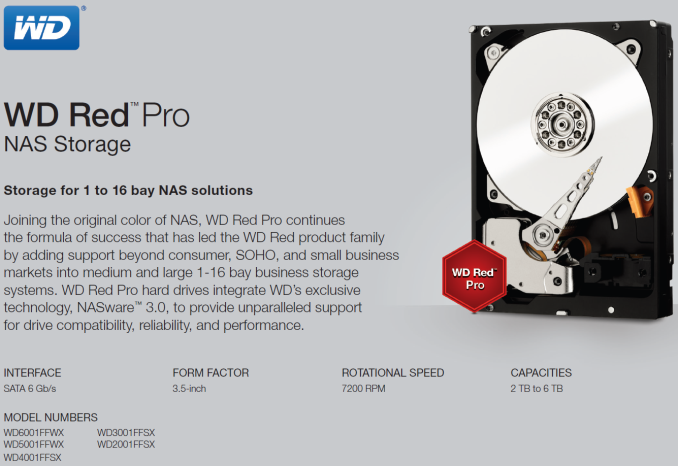WD Red Pro 6 TB Review - High Performance NAS HDD Gets a Capacity Bump
by Ganesh T S on September 7, 2015 8:00 AM EST- Posted in
- NAS
- Storage
- HDDs
- Western Digital
Concluding Remarks
The Western Digital Red Pro is the latest addition to our 6 TB drives evaluation set. We have taken a look at how it compares against the other 6 TB drives that have been evaluated before in both DAS and NAS scenarios. It is hard to recommend any particular 6 TB drive as the clear cut choice unless the particular application is known. The various hard drives in the comparison lot were launched targeting different markets and their resulting performance varies accordingly. At the most, the Seagate Enterprise NAS HDD and the WD Red Pro fall under the same category. However, they each win out on different workloads, with the Seagate drive enjoying a slight edge.
Thanks to the 7200 RPM speeds, the WD Red Pro does manage to acquit itself well in the overall performance category. Though it is not the absolute best, it performs admirably well in the sequential access patterns segment of the multi-client evaluation.
The WD Red Pro doesn't deliver the lowest power consumption. Those were recorded, as expected, with the 5400 RPM WD Red and the HelioSeal-technology based HGST Ultrastar He6. However, the WD Red Pro provides a good balance between speed and energy efficiency.
The WD Red Pro 6 TB version is priced at $300. At this price, users can also purchase the HGST Deskstar NAS 6 TB (though Newegg has reduced pricing for multiple disks in this case). The Seagate Enterprise NAS HDD comes in at $305, while the Enterprise Capacity v4 version comes in around $450. The choice at the $300 price point for 1-16 bay NAS units comes down to the WD Red Pro and the Seagate Enterprise NAS HDD. As mentioned earlier, the choice depends on the expected workloads.











62 Comments
View All Comments
Souka - Tuesday, September 8, 2015 - link
It would be even louder with four of these WD Red Pro drives!nagi603 - Monday, October 5, 2015 - link
The problem might also lie with your NAS: insufficient decoupling will lead to very nasty vibration, as is insufficient dampening or the use of not stiff enough components.beginner99 - Tuesday, September 8, 2015 - link
Well with the Pro only $33 more it's a no brainer. The 5 years warranty alone will make that a profitable investment alone.Visual - Tuesday, September 8, 2015 - link
Important details are missing from the article. It should be the first thing covered for drives of such capacities - make it clear if they are using a shingled write method requiring rewrites of large blocks for small random writes.Morawka - Tuesday, September 8, 2015 - link
anyone remember when all seagate consumer drives had 5 year warranties.. it was great. now we are lucky to get a 3 year warranty.FunBunny2 - Tuesday, September 8, 2015 - link
planned obsolescence is a wonderful thing. just ask Apple.star-affinity - Tuesday, September 8, 2015 - link
In what way is Apple worse than others when it comes to ”planned obsolescence”?valinor89 - Tuesday, September 8, 2015 - link
As far as I know Apple was the first mass consumer company to embrace the practice. Or at least the best known for it. Usually gadgets of other companyes were expected to be superceeded by advancing technology, not designed to fail after x time... One of the most famous examples was the Ipod Nano case.The practice existed before but apple put it in the spotlight.
Gigaplex - Sunday, September 13, 2015 - link
Apple is rarely the first to do anything. They certainly weren't the first to embrace planned obsolescence.Hannibal80 - Tuesday, September 8, 2015 - link
Why not moving to a 10gbe for the nas test? I think that for a soho scenario could make sense, with a direct 10gb connection between workstation and nas and classic 1gb link among remaining clients. Just my 2 cents